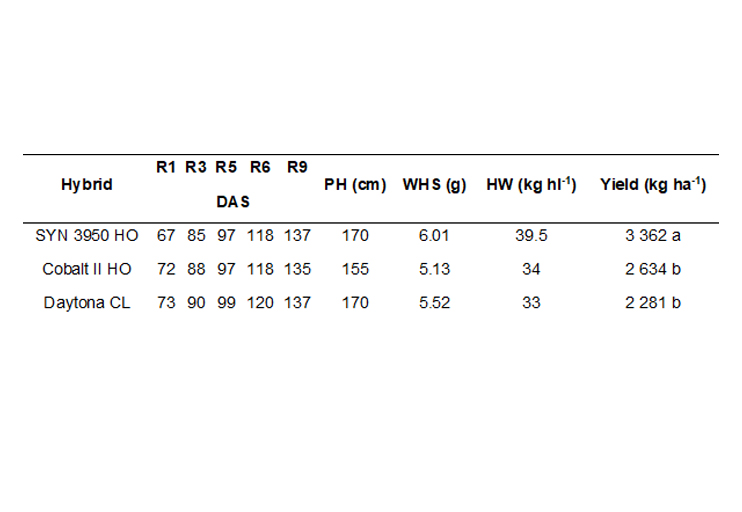Assessment of sunflower hybrid yield in southern Sonora
DOI:
https://doi.org/10.29312/remexca.v16i7.3640Keywords:
Helianthus annuus L., high oleic, sunflower productionAbstract
The sunflower (Helianthus annuus L.) is native to North America, originating in the southwestern United States of America and northern Mexico; the seed oil of sunflower varieties is considered of good quality for edible purposes. Likewise, limited water availability is a recurring problem in irrigation districts in southern Sonora, forcing producers to look for low-water crop options for the autumn-winter agricultural cycle; in this sense, sunflower is a crop with a low demand for water. The study aimed to identify sunflower hybrids, which would allow them to be suggested for planting to producers in southern Sonora. The trial was carried out in the 2020-2021 autumn-winter agricultural cycle. Commercial high oleic hybrids were used. The following agronomic characteristics were recorded: start and development of the flower bud, start and end of flowering, physiological maturity, plant height, weight of 100 seeds, hectoliter weight, and grain yield. The sunflower hybrid SYN 3 950 HO had yields of 3 362 and 3 596 kg ha-1, Cobalt II HO of 2 634 and 3 058 kg ha-1, and Daytona CL of 2 281 and 2 545 kg ha-1. The yields obtained from the sunflower hybrids evaluated allow us to suggest them for planting to producers in southern Sonora.
Downloads
References
Arenas, J. Y. R.; Escalante, E. J. A. S.; Aguilar, C. C.; Rodríguez, G. M. T. y Sosa, M. E. 2020. Rentabilidad y rendimiento de girasol en función del tipo de suelo, nitrógeno y biofertilizante. Biotecnia. 23(1):45-51.
Bye, B. R.; Linares, M. M. E. y Lentz, D. L. 2009. México: centro de origen de la domesticación del girasol. Revista Especializada en Ciencias Químico-Biológicas. 12(1):5-12.
Castillo, T. N.; Borbón, G. A. y Montoya, C. L. 2018. Tecnología de producción del cultivo de girasol para el estado de Sonora. Secretaría de Agricultura, Ganadería, Desarrollo Rural, Pesca y Alimentación (SAGARPA)-Instituto Nacional de Investigaciones Forestales, Agrícolas y Pecuarias (INIFAP)-Campo Experimental Norman E. Borlaug, Cd. Obregón Sonora, México. Memoria día del agricultor 2018, núm. 25. 30-32 pp.
Inzunza, I. M. A.; Sánchez, C. I.; Jiménez, J. S. I.; Catalán, V. E. A. y Marcial, P. M. J. 2022. Soil moisture depletion rates on sunflower yield. Ingeniería Agrícola y Biosistemas. 14(1):51-62. http://dx.doi.org/10.5154/r.inagbi.2021.09.105.
Martínez, F. E.; Turgut, D. N. and Salas, J. J. 2015. Sunflower, chemistry, production, processing and utilization. AOCS PRESS. Urbana, Illinois. 710 p.
Morales, M. E. J.; Morales, R. E. J.; Díaz, L. E.; Cruz, L. A. J.; Medina, A. N. y Guerrero, D. C. M. 2015. Tasa de asimilación neta y rendimiento de girasol en función de urea y urea de liberación lenta. Agrociencia. 49(2):163-176.
Raya, M. Y. A.; Apáez, B. M.; Lara, C. M. B. N. y Apáez, B. P. 2022. Producción de girasol (Helianthus annuus L.) con aplicación foliar de tierra diatomea. Acta Agrícola y Pecuaria. 8(1):1-9. https://doi.org/10.30973/aap/2022.8.0081001.
Rio Yaqui. 2024. Distrito de Riego del Río Yaqui. http://www.drryaqui.org.mx/sistemas-Presas.
Rodríguez, G. E.; Espino, A. A.; Barrios, E. P.; García, J. M. P. y Rodríguez, L. J. A. 2021. Evaluación del vigor híbrido en cruzas de girasol (Helianthus annuus L.) con líneas tempranas s1 de bajo contenido de aceite. Acta Universitaria. 31(I):1-16. https://doi.org/10.15174/au.2021.2905.
SAGARPA. 2023. Secretaría de Agricultura y Desarrollo Rural. Oleaginosas mexicanas (canola, cártamo, girasol y soya). Planeación agrícola nacional 2017-2030. http://www.consejagri.mx básico-oleaginosas.
Schneiter, A. A. and Miller, J. F. 1981. Description of sunflower growth stages. Crop Science. 21(6):901-903. https://doi.org/10.2135/cropsci1981.0011183X002100060024x.
SIAP. 2023. Sistema de Información Agroalimentaria y Pesquera. Anuario estadístico de la producción agrícola. https://www.gob.mx/siap/acciones-y-programas/produccion-agricola-33119.

Published
How to Cite
Issue
Section
License
Copyright (c) 2025 Revista Mexicana de Ciencias Agrícolas

This work is licensed under a Creative Commons Attribution-NonCommercial 4.0 International License.
The authors who publish in Revista Mexicana de Ciencias Agrícolas accept the following conditions:
In accordance with copyright laws, Revista Mexicana de Ciencias Agrícolas recognizes and respects the authors’ moral right and ownership of property rights which will be transferred to the journal for dissemination in open access. Invariably, all the authors have to sign a letter of transfer of property rights and of originality of the article to Instituto Nacional de Investigaciones Forestales, Agrícolas y Pecuarias (INIFAP) [National Institute of Forestry, Agricultural and Livestock Research]. The author(s) must pay a fee for the reception of articles before proceeding to editorial review.
All the texts published by Revista Mexicana de Ciencias Agrícolas —with no exception— are distributed under a Creative Commons License Attribution-NonCommercial 4.0 International (CC BY-NC 4.0), which allows third parties to use the publication as long as the work’s authorship and its first publication in this journal are mentioned.
The author(s) can enter into independent and additional contractual agreements for the nonexclusive distribution of the version of the article published in Revista Mexicana de Ciencias Agrícolas (for example include it into an institutional repository or publish it in a book) as long as it is clearly and explicitly indicated that the work was published for the first time in Revista Mexicana de Ciencias Agrícolas.
For all the above, the authors shall send the Letter-transfer of Property Rights for the first publication duly filled in and signed by the author(s). This form must be sent as a PDF file to: revista_atm@yahoo.com.mx; cienciasagricola@inifap.gob.mx; remexca2017@gmail.
This work is licensed under a Creative Commons Attribution-Noncommercial 4.0 International license.


